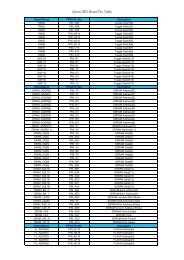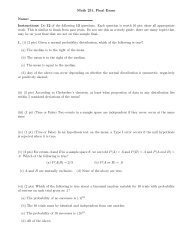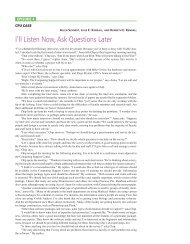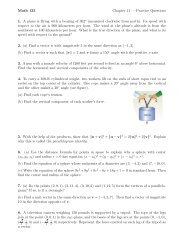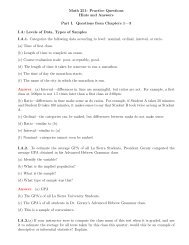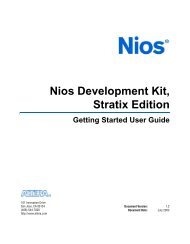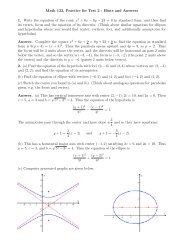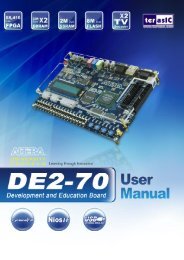Test 3 - Faculty.lasierra.edu
Test 3 - Faculty.lasierra.edu
Test 3 - Faculty.lasierra.edu
Create successful ePaper yourself
Turn your PDF publications into a flip-book with our unique Google optimized e-Paper software.
Math 251: Practice Questions for <strong>Test</strong> IIIHints and AnswersIII.A: The Central Limit Theorem and Sampling Distributions.III.A.1 The heights of 18-year-old men are approximately normally distributed with mean 68 inchesand standard deviation 3 inches.(a) What is the probability that a randomly selected 18-year-old man is between 67 and 69 inchestall.(b) If a random sample of nine 18-year-oldmen is selected, what is the probability that the meanheight ¯x is between 67 and 69 inches?(c) Is the probability in (b) higher? Why would you expect this?Answer. (a) Convert x to z using z = x − µσ. ThenP (67 ≤ x ≤ 69) = P (−.33 ≤ z ≤ .33) = .6293 − .3707 = .2586.(b) The sample size is n = 9, and so σ¯x = σ/ √ 9 = 3/3 = 1. Then convert ¯x to z using z = x − µσ x.Therefore,P (67 ≤ ¯x ≤ 69) = P (−1 ≤ z ≤ 1) = .6826.(c) Yes. One would expect averages of groups to have a much higher probability of being close tothe mean, than an individual measurement. Mathematically, this is true because σ¯x < σ.III.A.2 Suppose the taxi and takeoff time for commercial jets is a random variable x with a meanof 8.5 minutes and a standard deviation of 2.5 minutes. What is the probability that for 36 jets ona given runway total taxi and takeoff time will be(a) less than 320 minutes?(b) more than 275 minutes?(c) between 275 and 320 minutes?Answer. Because n ≥ 30 we may apply the central limit theorem. For this, σ¯x = σ/ √ 36 = 2.5/6 ≈.4167.(a) Convert 320 to an average, that is 320/36 = 8.89. Then()8.89 − 8.5P (¯x ≤ 8.89) = P z ≤ = P (z ≤ .93) = .8238..4167(b) Convert 275 to an average: 275/36 = 7.638. Then()7.638 − 8.5P (¯x ≥ 7.638) = P z ≤ = P (z ≥ −2.07) = 1 − .0192 = .9808..4167(c) P (−2.07 ≤ z ≤ .93) = .8328 − .0192 = .8046
(b) Find the 90% confidence interval for the mean amount of money farmers will receive for 15 tonsof watermelon. What is the margin of error?Answer. (a) First for c = .90, then z .90 = 1.645 and then the margin of error is E = 1.645 1.92 √40≈ .50.Therefore, the 90% confidence interval is 6.38 < z < 7.38For c = .99, then z .99 = 2.58, and then the margin of error is E = 2.58 1.92 √40≈ .7832. Then the 99%interval is 6.097 < z < 7.663.A longer confidence interval should be expected for a higher confidence, because the longer theinterval, the more likely it will contain the true population mean.(b) For this case, multiply answers in (a) by 300, because 15 tons is 300 times 100lbs. Thus, forc = .90, the margin of error is 150, and the confidence interval is 1914 < z < 2214.III.B.3. Suppose you wish to find the average annual salary for school teachers in the United States.Suppose you took a random sample and found that ¯x = 53, 145 and you estimated σ = $16, 451.Find a 95% confidence interval for the mean salary, given that your sample had size (a) n = 36, (b)n = 64, (c) n = 144.(d) Does the margin of error increase or decrease as n gets larger. What effect did quadrupling nhave on the margin of error?(e) Does the confidence interval get longer or shorter as the sample size increases? Is that what youwould expect?Answer. (a) E = 1.96 16451 √36≈ 5374, thus the 95% confidence interval is 47771 < z < 58519.(b) E = 1.96 16451 √64≈ 4031, thus the 95% confidence interval is 49114 < z < 57176.(c) E = 1.96 16451 √144≈ 2687, thus the 95% confidence interval is 50458 < z < 55832.(d) The margin of error decreases as n gets larger. If n is quadrupled, the margin of error is cut bya factor of 2 (since 2 is the square root of 4).(e) Confidence intervals get shorter as sample sizes increase. One should expect this, because thelarger the sample size, the better its chance of more accurately representing the population.III.B.4. Price to earnings ratios of stock from a random selection of 51 large company stocks aregiven (see your text). Using the formulas¯x =∑ xn√ ∑x2 − (P x) 2and s =n − 1nit was computed that ¯x = 25.2 and s ≈ 15.5.(a) Find a 90% confidence interval for the P/E population mean for all large U.S. companies.(b) Repeat (a) with a 99% confidence level.(c) How do companies with P/E’s of 12, 72 and 24 compare to the population mean?(d) Is it necessary to assume that x is approximately normal for this case?
Answer. (a) For this case ¯x = 25.2, s ≈ 15.5, and n = 51. Therefore, d.f. = 50, and using thetable we find that t .9 = 1.676. The endpoints of the confidence interval areand so the interval is 21.56 to 28.84.25.2 ± 1.676 15.5 √51(b) The only thing that changes is t c = 2.678 in this case, so the interval is 19.39 to 31.01.(c) 24 well within the 99% confidence interval, so it is probably close to the mean, but neither 72nor 12 are in the 99% confidence interval, so we are very certain that those P/E ratios are higherand lower than the mean respectively.(d) No, the central limit theorem says that the sampling distribution is approximately normal forsufficiently large n.II.B.5. Total calcium. A total calcium level below 6mg/dl is related to severe muscle spasms.Recently, the patients total calcium tests gave the following readings (in mg/dl).9.3 8.8 10.1 8.9 9.4 9.8 10.0 9.9 11.2 12.1(a) Verify that ¯x = 9.95 and s ≈ 1.02. What formulas did you use?(b) Find a 99.9% confidence interval for the population mean of total calcium in this patients blood.(c) Do you think the patient still has a calcium deficiency?(d) What properties should the distribution possess for the confidence interval in (b) to be valid?Answer. (a) Use the formulas¯x =∑ xn√ ∑x2 − (P x) 2and s =n − 1nas you did in chapter 3.(b) For this, n = 10, ¯x = 9.95, s ≈ 1.02, d.f. = 9, and so t .999 = 4.781 and the confidence intervalhas endpoints9.95 ± 4.781 1.02 √10which means the 99.9% interval for the population mean is from 8.41 to 11.49.(c) No, the lowest point of the confidence interval is 8.41, so we are very certain (99.9%) that themean is above 8.41 (and below 11.49).(d) Because the sample size is small (less than 30), the original distribution must be normal, or atleast approximately normal.III.B.6. The Roman Arches is an Italian restaurant. The manager wants to estimate the averageamount a customer spends on lunch Monday through Friday. A random sample of 115 customers’lunch tabs gave a mean of ¯x = $9.74 with a standard deviation s = $2.93.(a) Find a 95% confidence interval for the average amount spent on lunch by all customers.
(b) For a day when the Roman Arches has 115 lunch customers, use part (a) to estimate the rangeof dollar values for the total lunch income that day.Answer. (a) The sample size is n = 115 ≥ 30, but the population standard deviation is not knownso we will use the t-distribution with d.f. = 114, from our table we estimate t c = 1.984 (since we goto d.f. = 100). ThusE = 1.984 ·2.93√115≈ .542 so the interval is (9.20, 10.28)So we are 95% confident the mean amount is from $9.20 to $10.28.(b) We are 95% confident that total would be in the range (115 · $9.20, 115 · $10.28), that is($1058, $1182).III.B.7. The number of calories for 3 ounces of french fries at eight popular fast food chains are asfollows.222 255 254 230 249 222 237 287Use these data to find a 99% confidence interval for the mean calorie count in 3 ounces of frenchfries obtained from fast-food restaurants.Answer. First, one needs to compute the sample mean and sample standard deviation for the 8numbers above. For this, one finds∑ ∑x = 1956 x 2 = 481548 SS x = 481548 − 195628= 3306.Thus ¯x = 19568√3306= 244.5 and s = = 21.73.7This is a small sample (n < 30) with unknown standard deviation, and we’ll assume the populationis normal, or nearly so. We use the t-distribution with 7 degrees of freedom, thus t .99 = 3.499, andsthe endpoints of the confidence interval are given by ¯x ± t c √ . Thus the 99% confidence intervalnhas endpoints 244.5 ± 3.499 21.73 √8which yields the interval (217.6, 271.4).III.C. Confidence Intervals on ProportionsIII.C.1. A recent poll reported that 23% of adult Americans surveyed approve of the way the UnitedStates has handled the war in Iraq. Moreover, the polling organization reported their methods wereas follows.“These results are based on telephone interviews with a randomly selected national sample of 1,006adults, aged 18 and older, conducted Feb. 24-26, 2007. For results based on this sample, one cansay with 95% confidence that the maximum error attributable to sampling and other random effectsis ±3 percentage points. In addition to sampling error, question wording and practical difficultiesin conducting surveys can introduce error or bias into the findings of public opinion polls.”(a) What is the confidence interval that polling organization is suggesting for the proportion of adultAmericans favoring the way the U.S. has handled war in Iraq?
(b) Find a 99% confidence interval for the proportion of adult Americans that approve of the waythe United States has handled the war in Iraq.(c) Explain (or show) why the conditions necessary for constructing a confidence interval on aproportion are satisfied in this case.Answer. (a) Interval: .20 < p < .26 Level of Confidence: c = .95√(.23)(.77)(b) First, z c = 2.58 and E = 2.58≈ .0342. The endpoints of the interval are then1006.23 ± .0342. Therefore, the confidence interval is.1958 < p < .2642 with 99% confidence(c) Because both np ≈ (1006)(.23) > 5 and nq ≈ (1006)(.77) > 5.III.C.3. In a 2003 Gallup poll it was reported that 47% of adult Americans surveyed approve ofthe way the United States has handled the war in Iraq. Moreover, Gallup reported their methodswere as follows:“These results are based on telephone interviews with a randomly selected national sample of 1,006adults, aged 18 and older, conducted Oct. 24-26, 2003. For results based on this sample, one cansay with 95% confidence that the maximum error attributable to sampling and other random effectsis ±3 percentage points. In addition to sampling error, question wording and practical difficultiesin conducting surveys can introduce error or bias into the findings of public opinion polls.”(a) What is the confidence interval that Gallup is suggesting for the proportion of adult Americansfavoring the way the U.S. has handled war in Iraq?(b) Find a 99% confidence interval for the proportion of adult Americans that approve of the waythe United States has handled the war in Iraq.(c) What sample size would be needed to estimate the proportion of adult Americans that approveof the way the United States has handled the war in Iraq to within ±.01 with 95% confidence?Answer. (a) Gallup is claiming that the 95% confidence interval for the proportion is (.44, .50).(b) We are given ˆp = .47, n = 1006.√Now, ˆq = .53 and clearly nˆp > 5 and nˆq > 5 so we can usepqthe formulas ˆp ± z c σˆp where σˆp =n . Using the table we find z .99 = 2.58. Therefore, the 99%√(.47)(.53)confidence interval is .47 ± 2.58which yields the interval (0.4294, 0.5106).1006( zc) 2 ((c) If we use p = .47 as an estimate for p in the formula n = pq we get n = (.47)(.53) 1.96) 2.01 =E9569.43 and so we would use n = 9570. If we don’t assume an initial estimate for p, we getn = 1 ( zc) 2= 9605.4 EIII.C.4. A recent Gallup poll of 1006 adult Americans found that 37% of those asked oppose cloningof human organs.(a) Find a 98% confidence interval for the proportion of adult Americans that oppose cloning ofhuman organs.
(b) Based on the answer to (a), would it be appropriate for the Gallup organization to state thatless than 38% of adult Americans oppose cloning of human organs? Explain.Answer. (a) First z .98 = 2.33 (use table), ˆp = .37 and n = 1006. Now nˆp > 5 and nˆq > 5 and sowe can use the confidence interval formula for proportions since the sampling distribution will beapproximately normal. Therefore, the 98% confidence interval has endpoints√(.37)(.63).37 ± 2.331006That gives a confidence interval of (.3345, .4055).(b) Because the upper end of the confidence interval is 40.55% which is well above 38%, it would notbe appropriate to state that less that 38% of all adult Americans oppose cloning of human organsusing this confidence interval.III.C.5. On June 7, 1999 a poll on the USA Today website showed that out of 2000 respondents,71% felt that Andre Agassi deserved to be ranked among the greatest tennis players ever.(a) Assuming that the 2000 respondents form a random sample of the population of tennis fans,construct a 95% confidence interval for the proportion of all tennis fans who feel that Andre Agassishould be ranked among the greatest tennis players ever.(b) Based on (a), would you be comfortable in saying that the poll is accurate to within plus orminus 2 percent 19 times out of 20? Explain.(c) In actuality, the survey was based on voluntary responses from readers of the USA Today sportswebsite. Do you think the 2000 respondents actually formed random sample? Explain.Answer. (a) The confidence interval is (.6901, .7299). To find this confidence interval we foundz .95 = 1.96, √ˆp = .71, ˆq = .29 and n = 2000. Clearly nˆp > 5 and nˆq > 5 and so we computed:(0.71)(0.29).71 ± 1.96 ·= .71 ± .0199 to find the endpoints of the interval.2000(b) Yes, the 95% confidence interval is .71 ± .0199, hence intervals based on this size of randomsample with the given proportion should have an accuracy of ±2% on average 19 times out of 20.(c) No – the readership of the website is limited to those who have access to the site and choose tovisit it; moreover, the survey was not based on a random selection of even those users of the website,but on those who chose to respond to the poll.III.C.6. (Section 8.3#2) In a sample of 519 judges it was found that 285 were introverts.(a) Let p represent the proportion of all judges who are introverts. Find a point estimate for p.(b) Find a 99% confidence interval for p, and explain what it means.(c) Do you think np > 5 and nq > 5 for this problem? Why, and why is it important?Answer. (a) ˆp = 285519 ≈ .5491.(b) z c = 2.58, n = 519, ˆp = .5491, ˆq = .4509 and soE = 2.58√(.549)(.451)519≈ .05635,and so .4927 < p < .6054 with 99% confidence
(c) Yes, because there are far more than 5 successes (285) and far more than 5 failures (234) inthe sample. This is important, because the confidence interval in (b) relies on the fact that thedistribution is approximately normal.III.C.7. (Section 8.3 #17) In a survey of 1000 large corporations, 250 said given a choice betweena job candidate who smokes and an equally qualified nonsmoker, the nonsmoker would get the job(USA Today).(a) Let p represent the proportion of all corporations preferring a nonsmoking candidate. Find apoint estimate for p.(b) Find a 95% confidence interval for p.(c) How would a news writer report these results? What was the margin of error for the 95%confidence interval?Answer. (a) ˆp = 2501000 = .250(b) z c = 1.96, n = 1000, ˆp = .250, and ˆq = .750. Therefore we compute E and then ˆp ± E will bethe endpoints of the interval.E = 1.96√(.25)(.75)1000≈ .02684 and so .2231 < p < .2768 with 95% confidence.(c) A survey of 1000 large corporations has shown that 25% would intentionally hire a nonsmokerover an equally qualified smoker. The poll is accurate to within ±2.7 percent 19 times out of 20.III.D. Sample Sizes for Confidence IntervalsIII.D.1. A sample of 37 adult male desert bighorn sheep indicated the standard deviation of thesheep weights to be 15.8 lb (Source: The Bighorn of Death Valley...) How many adult male sheepshould be included in a sample to be 90% sure that the sample mean weight ¯x is within 2.5 lb ofthe population mean weight µ for all such bighorn in the region.(b) Repeat the question in (a), but given you found an error in the original calculation and thestandard deviation was 25.8 lb.(c) Repeat the question in (a), but you double checked, and the standard deviation of 15.8 lb wascorrect, but you decided you need a 99% confidence interval.Answer. (a) For this question z c = 1.645, σ = 15.8 and the desired E = 2.5. Therefore,( zc σ) ( ) 2 2 (1.645)(15.8)n = = ≈ 108.09 thus choose a sample size of n = 109.E2.5(b) Same as (a), except σ = 25.8, and so n ≈ 288.2 and so we would use a sample size of n = 289.(c) Same as (a), except z c = 2.58, and so n =sample size of n = 266.( ) 2 (2.58)(15.8)≈ 265.9 and so we would use a2.5III.D.2 (Sample Sizes for Proportions) Suppose president Bush decides to conduct a survey concerningthe support for sending additional troops to Iraq.
(a) What sample size would he need to estimate the percentage within ±3% with 95% confidence?(assume he doesn’t have an initial estimate for the true proportion)(b) Same question as (a), but within ±1% with 95% confidence.(c) Same question as (a), but within ±3% with 99% confidence.(d) Repeat questions (a) through (c), but assume to start with that a news poll estimated that 27%of Americans support sending additional troups, and that the president used this as a good startingestimate for p.(e) Approximately what sample size do you think the Gallup Organization uses to create polls thatare accurate to ±3 percent 19 times out of 20?Answer. (a) For this part, z c = 1.96, the desired E = .03, and there is no initial estimate for p, son = 1 ( zc) ( ) 2 21 1.96= n = ≈ 1067.14 E 4 .03This means he should use a sample size of 1068.(b) In this case E = .01, and son = 1 4( zc) 2 1 = n =E 4( ) 2 1.96= 9604..01Notice the huge increase in sample size from (a) to 9604 to get within 1 percent.(c) Same as (a), except z c = 2.58 and so n = 1849 using the same formula.( zc) 2(d) Now use the formula n = pq where we use .27 as an estimate for p, and .73 as an estimateEfor q. To to get an accurace of .03 with 95 percent confidence, then( zc) ( ) 2 2 1.96n = pq ≈ (.27)(.73) ≈ 841.3E.03and so a sample size of n = 842 would be sufficient. Use the same formula for the other parts, butwith E = .01 in the next calculation, and z c = 2.58 in the final calculation.(e) They will never need a random sample larger than 1068 (see (a)). If there is a good estimate forp, they may be able to use a smaller sample (see (d)). If you look at the fine print of some polls,you will see that often a sample size of approximately 1000 is used.III.D.3. (a) What sample size would be needed to estimate the mean from a population withstandard deviation of 100 with a maximum error of 5 with 95% confidence?(b) What sample size from the same population would be needed to estimate the mean with amaximum error of 10 with 95% confidence?(c) In general, what effect would increasing a sample size by a factor of 16 have on the maximumerror E?(d) In general, how much must a sample size be increased to cut the maximum error by one-half?Answer. (a) We use the formula n =n = 1537.( zc σE) ( ) 2, 2 1.96 · 100and so n = = 1536.64 and so we use5
( zc σ) ( ) 2, 2 1.96 · 100(b) We use the formula n = and so n = = 384.16 (which is one-fourth of theE10answer in (a)). Going to up to the next whole number, we get n = 385.(c) Multiplying the sample size by 16 r<strong>edu</strong>ces the error to one-fourth of what it was with the originalσsample size. This is verified with the following calculation. If E = z c √n the error with the originalsample size, then the error with a sample 16 times the size of the original isz cσ√ = 1 16n 4 z σc √ = 1 n 4 E.(d) The sample size must be quadrupled. This is verified with the following calculation. If n =( zc σ) 2is the original sample size, then sample size needed to halve E isE() 2z c σ= 4E2( zc σ) 2= 4n.EIII.E. Confidence Intervals on Differenes of means/proportionsIII.E.1. A government official wishes to determine if there has been “grade inflation” for graduatingseniors in her state’s high schools over the last 10 years. So she took random sample of 900 graduatingseniors GPA’s in 1996 and found the sample to have a mean GPA of 3.13 and a standard deviationof .56, and she found a sample of 1225 graduating seniors in 2006 had a mean GPA of 3.29 with astandard deviation of .53.(a) Help this official by constructing a 99% confidence interval for the difference of the populationmeans, use the 1996 GPA’s as population 1. Assume the standard deviations given are also thepopulation standard deivations.(b) Describe in words (like a news reporter) what the inveral in (a) means.(c) Based on your answer in (a), would you be convinced that there has been grade inflation in thatstate? Explain.Answer. (a) E = 2.58so√(.56)2900 + (.53)21225 ≈ .062. The endpoints of the interval are ¯x 1 − ¯x 2 ± E and−.222 < µ 1 − µ 2 < −.098 with 99% confidence.(b) We are 99% confidenct that the average GPA of high school graduates in the state in 1996 were.222 to .098 lower than the average GPA of high school graduates in the state in 2006.(c) Yes, we are 99% certain that the GPA’s are least .098 higher in 2006 than they were in 1996.III.E.2. In a 1999 survey of 80 Computer Science graduates and 110 Electrical Engineering graduates,it was found that the Computer Science graduates had a mean starting salary of $48, 100with a standard deviation of $7, 200, while the Electrical Engineering graduates had a mean startingsalary of $52, 900 with a standard deviation of $5, 300.(a) Find a point estimate for the difference in average starting salaries for Computer Science andElectrical Engineering graduates.
(b) Let µ 1 be the population mean starting salary for the Computer Science graduates and let µ 2 bethe population mean salary for the Electrical Engineering graduates. Find a 96% confidence intervalfor µ 1 − µ 2 . Assume the standard deviations given are the population standard deviations.(c) Based on the interval in (b), would you be comfortable saying that the mean starting salary forComputer Science graduates is less than that for Electrical Engineering graduates? Explain.(d) How would your answer change if the standard deviations given are sample standard deviations,and you were asked to find a 95% confidence interval?Answer. (a) The reasonable point estimate is ¯x 1 − ¯x 2 = 48, 100 − 52, 900 = −4800.(b) Since each sample size is at least 30, we use the formula:¯x 1 − ¯x 2 ± z c σ¯x1 −¯x 2where σ¯x1 −¯x 2=√σ 2 1n 1+ σ2 2n 2For this, c = .96 and so z .96 = 2.05 (which is found from the normal table as the z-value for whichP (z < z c ) = .98 since .98 = .5 + .96/2). Now compute√7, 20025, 3002σ¯x1 −¯x 2= + = 950.4580 110and so we compute −4800 ± 2.05 · 950.45 which yields the interval (−$6, 748.43, −$2, 851.57). Thismeans that we are 96% confident that the true difference in salaries is between −$6, 748.43 and−$2, 851.57, i.e. we are very confident that the Computer Science graduates’ starting mean salaryis from $2,851.57 to $6,748.43 less than Electrical Engineering graduates’ mean starting salaries.(c) Yes, we are very confident that it is at least $2,851.57 less than the mean for Electrical Engineeringgraduates.(d) Use the t-ditribution with d.f. = 79, which is not on our table, so we use the next lower numberwith is 70. For this t .95 = 1.994 in place of the z .96 = 2.05III.E.3 (a) A Gallup News Release (see http://www.gallup.com/poll/releases/pr031030.asp) reportedthat in July 1996, 69% of those surveyed supported assisted suicide for terminally ill, whilein May 2003, 72% of those surveyed supported assisted suicide for the terminally ill. Assume the1996 poll surveyed 1103 adult Americans, while the May 2003 poll surveyed 1009 adult Americans.Find a 99% confidence interval for p 1 − p 2 where p 1 is the proportion of adult Americans supportingassisted suicide in July 1996, and p 2 is the proportion of adult Americans supporting assisted suicidein May 2003.(b) Based on your interval in (a) would you be comfortable in saying that the proportion of adultAmericans supporting assisted suicide was higher in May 2003 than in July 1996? Explain.Answer. (a) First, because n 1ˆp 1 = (1103)(.69) > 5, n 1ˆq 1 = (1103)(.31) > 5, n 2ˆp 2 = (1009)(.72) > 5and n 2ˆq 2 = (1009)(.28) > 5, we can use the formula√p1 q 1ˆp 2 − ˆp 2 ± z c σˆp1 −ˆp 2where σˆp1 −ˆp 2= + p 2q 2.n 1 n 2With c = .99 we find z .99 = 2.58 from the table, and we compute√ˆp1ˆq 1σˆp1 −ˆp 2= + ˆp √2ˆq 2 (.69)(.31)=+ (.72)(.28)n 1 n 2 1103 1009= .0198426
The 99% confidence interval has endpoints (.69 − .72) ± 2.58 · .0198436, thus the interval is(−.0812, .0212). We are 99% confident in July 1996 the percentage of adult Americans that supportedassisted suicide was 8.12% less to 2.12% more than the percentage in May 2003.(b) No, I could not say that with 99% confidence because the interval found in (a) included thepossibility that the support was up to 2.12% higher in July 1996 than in May 2003.III.F. Hypothesis <strong>Test</strong>s on MeansIII.F.1 (Length of time to complete a form) You wish to test claim that the average time to completea form is 15 minutes. You believe it is longer. For this, you surveyed a random sample of 45 peopleand found that it took them an average of 17 minutes to complete the form with a standard deviationof 5 minutes which you have reason to believe is the population standard deviation. Conduct yourtest with a level of significance of α = .05.Answer. The hypotheses are: H 0 : µ = 15; H 1 : µ > 15.The test statistic is z = ¯x − µσ/ √ n=17 − 155/ √ 45 = 2.68.The P-value is P (z ≥ 2.68) = .037. Because .037 < .05, you reject the null hypothesis. The averagetime is longer than 15 minutes.III.F.2 For healthy adults, the mean blood pH is µ = 7.4. It is suspected a new arthritis drugchanges blood pH (either higher or lower). <strong>Test</strong> this at a 5% significance level. To do this, a sampleof 31 patients on the new drug were tested, and the sample had a mean ¯x = 8.1 and assume thepopulation standard deviation is 1.9.Answer. The hypotheses are: H 0 : µ = 7.4; H 1 : µ ≠ 7.4, and α = .05.The test statistic is z = ¯x − µσ/ √ n=8.1 − 7.41.9/ √ 31 = 2.05.The P-value is P (z < −2.05) + P (z > 2.05) = 2(.0202) = 0.0404Because the P-value is less than α, we reject H 0 . That is we are quite certain that the drug doeschange blood pH.III.F.3 (Do SDA’s live Longer?) Suppose the average life span of an American is 76 years witha standard deviation of 14 years. <strong>Test</strong> at a level of significance of α = .01 whether the averageAmerican SDA life span is longer. For this, suppose that a random sample of 400 recently recordedSDA deaths had an average life span of 78 years, and that the standard deviation was also 14 years.(Do the test using P-value method, and then using the critical region method)Answer. (P-Value Method) The hypotheses are: H 0 : µ = 76; H 1 : µ > 76, α = .01.The test statistic isz =78 − 7614/ √ 400 = 2.86The P-value is P (z > 2.86) = .0021. Because the P-value is less than .01, we reject H 0 , that is, theevidence does show that on average SDA’s live longer than 76 years.
(Critical Region) For α = .01 on a right-tailed test, the critical region is z ≥ 2.33, because thez = 2.86 > 2.33 is in the critical region, as with the P -value, we reject H 0 , the evidence suggeststhat on average SDA’s live longer than 76 years.III.F.4. The 13 Feb 2007 AAA survey of gasoline prices found that the average price for regular gasin Riverside was 2.602 (from AAA website). Suppose the Riverside Chamber of Commerce thoughtthis price was not accurate, and wanted to prove that the gas price is actually lower. Suppose theirsurvey of 80 randomly selected gas stations in Riverside and had a sample mean ¯x = 2.576 with astandard deviation of 0.152 which we assume is also the population standard deviation. Conduct anhypothesis test to determine if the mean is lower than 2.602 using a 5% level of significance.Answer. The hypotheses are: H 0 : µ = 2.602 and H 1 : µ < 2.602, and α = .05.z =2.576 − 2.602.152/ √ 80≈ −1.53The P-value is P (z < −1.53) = .0618. Because the P-value is larger than α, there is not sufficientevidence at the 5% significance level to show that the mean gas price in Riverside is less than 2.602.III.F.5. (a) Find the critical region if a two-tailed test on a mean is conducted using a large sampleat a level of significance of .01.(b) Explain what type I and type II errors are in hypothesis tests.(c) What is the probability with which we are willing to risk a type I error called?Answer. (a) With the help of the normal table in the front cover, we find that the critical regionis z ≤ −2.58 or z ≥ 2.58.(b) See text Section 9.1.(c) The level of significance, which is denoted by α.III.F.6. (a) A developer wishes to test whether the mean depth of water below the surface in alarge development tract was less than 500 feet. The sample data was as follows: n = 32 test holes,the sample mean was 486 feet, and the standard deviation was 53 feet, assume that this is thepopulation standard deviation σ = 53. Complete the test by computing the Pvalue, and report theconclusion for a 1% level of significance.(b) What would the conclusion of the test be for a level of significance of α = .05.(c) What type of error was possibly made in (b)?Answer. H 0 : µ = 500H 1 : µ < 500Using the sample data, we computez =486 − 50053 √32= −1.49Thus the Pvalue is P (z < −1.49) = .0681 We would not reject the null hypothesis at a level ofsignificance of .01, because the P-value is larger than 0.01. Thus the data does not show at the 5%significance level that the average water depth is less than 500 feet.
(b) Do not reject H 0 since the Pvalue is bigger than .05.(c) A type II error–we did not reject the null hypothesis when it could possibly be false.III.F.7. (Connecting Hypothesis <strong>Test</strong>s and Confidence Intervals) A vendor was concerned that asoft drink machine was not dispensing 6 ounces per cup, on average. A sample size of 40 gave amean amount per cup of 5.95 ounces and a standard deviation of .15 ounce, again assume that weknow σ = .15(a) Find the Pvalue for an hypothesis test to determine if the mean is different from 6 ounces.(b) For which of the following levels of significance would the null hypothesis be rejected?(i) α = .10 (ii) α = .05 (iii ) α = .04 (iv) α = .01(c) For each case in part (b), what type of error has possibly been committed?(d) Find a 96% confidence interval for the mean amount of soda dispensed per cup.(e) Is your interval in (d) consistent with the test conclusion in (b)(iii)? Explain.(f) Based on your answer to (b)(iv) would you expect a 99% confidence interval to contain 6?(g) Suppose that the population standard deviation is σ = .15, what sample size would be neededso that the maximum error in a 96% confidence interval is E = .01?Answer. (a) This is a two-tailed test withNull Hypothesis: µ = 6Alternative Hypothesis: µ ≠ 6.Using the data, we computez = 5.95 − 6.15 √40= −2.11.The Pvalue is: P (z < −2.11) + P (z > 2.11) = 2 · P (z < −2.11) = 2(.0174) = .0348(b) Reject the null hypothesis in (i), (ii) and (iii) since the Pvalue is smaller than α; do not rejectthe null hypothesis in (iv).(c) Possible Type I error may occur in (i), (ii) and (iii) while a Type II error may occur in (iv).(d) For c = .96, z c = 2.05 (approximately), look at z value corresponding to an area of .98 on table.Thus the confidence interval, using the large sample method (n is at least 30) yields endpoints:5.95 ± 2.05 ·.15√40and, so the confidence interval is: (5.901, 5.999).(e) Yes. In (b)(iii) we have a confidence level of (at least) c = 1 − α = .96 that the mean is differentfrom 6, while in (d) we had a 96% confidence interval that did not contain 6, and so we were (atleast) 96% certain that the mean is different from 6. Notice also the confidence interval comes veryclose to containing 6, this is reflected in the Pvalue being very close to 0.04 in the hypothesis test.(f) Yes, because we were not 99% confident that the mean was different from 6, we would expectthe corresponding confidence interval to contain 6.
(g) The formula to use is: n =thus we should use a sample size of n = 946.( zc σ) 2.So we computeE( ) 2 2.05 · .15n == 945.5625,.01III.G Short Answer Questions from topics in III.III.G.1 Explain how you decide when to use normal distribution or t-distribution when(a) finding confidence intervals for a mean;(b) finding confidence intervals for a difference of two means;(c) conducting and hypothesis test on a population mean.In each case, what formulas do you use, if using the t-distribution how many degrees of freedom doyou use, what assumptions are necessary on the distribution(s) and or sample sizes?Answer. See your Text!III.G.2. (a) What is the significance of the Central Limit Theorem, and what does it say?(b) Letx be a random variable from any population with mean µ and standard deviation σ. What typeof distribution will the distribution for the mean from samples of size n with n large approximate?What are the mean and standard deviation for the sampling distribution of sample size n?Answer. (a) Reasons for its importance is that we do not need to assume a population is normalwhen finding confidence intervals for the mean or when conducting hypothesis tests on a mean whensample sizes are large. For the rest of (a) and (b) see your text.III.G.3. Find the mean and standard deviation for the distribution for ¯x based on a random sampleof size 64 from a population with mean 37 and standard deviation 24.Answer. µ¯x = 37 and σ¯x = 24 √64= 3.III.G.4. (a) What conditions are necessary in order to find a confidence interval for a proportion?(b) Same question, but for a confidence interval for the difference of two proportions?(c) Same question, but for an hypothesis test on a proportion.(d) In each of the above cases, what formulas do you use?Answer. See your text.III.G.5 If a population has a standard deviation of 5, what sample size would be necessary in orderfor a 99% confidence interval to estimate the population mean within 2?( zc σ) ( ) 2 2 2.58 · 5Answer. We use the formula n = and we find that n = = 41.6025. The sampleE2size must be the next larger whole number which is n = 42.
III.G.6. What size of random sample is needed by the Gallup organization to estimate a populationproportion within ±.02 with 90% confidence? In your calculation assume that there is no preliminaryestimate for p.Answer. We use the formula n = 1 ( zc) ( ) 2 21 1.645 = = 1691.265 and so we use a sample size4 E 4 .02at the next larger whole number which is n = 1692.III.G.7. Repeat III.G.6., but assume that there is a preliminary estimate that p = .33.( zc) ( ) 2 2 1.645Answer. We use the formula n = pq = (.33)(.67) = 1495.76 and so we use aE.02sample size at the next larger whole number which is n = 1496.III.G.8. Suppose you are to construct a 95% confidence interval for the mean using a sample ofsize n=19 from a normal population with unknown standard deviation. What value of t c would youuse in your confidence interval formula?Answer. We use a t-distribution with n − 1 = 18 degrees of freedom, and look on the table in theback cover to find t .95 = 2.101III.G.9. Suppose you are to construct a 92% confidence interval for the mean using a large samplefrom a population with known standard deviation, what value of z c would you use?Answer. We find z .92 = 1.75 (use the table for areas of the standard normal, find the z-valuecorresponding to an area of .5 + .92/2 = .96).III.G.10. Which distribution (normal or t with how many d.f.) would you use to find a confidenceinterval from a normal population with known standard deviation given a sample size of 15?Answer. Normal distribution because the population standard deviation is known.III.G.11. Explain what Type I and Type II errors are in hypothesis tests.Answer. See your text.III.G.12. Explain what the level of significance of an hypothesis test is in terms of Type I errors.Answer. In short, the probability you are willing to risk making a Type I error. See text for more.III.G.13. (a) If you did a right-tailed hypothesis test on a mean, and found that z = 2.13, whatP -value would you report.(b) Same question, but with a two-tailed test.(c) Same question, but with a left-tailed test.(d) Same question, for left-tailed test, but z = −2.13.Answer. (a) P (z > 2.13) = 1 − .9834 = .0166
(b) 2(.0166) = .0332(c) Huge: P (z < 2.13) = .9834.(d) P (z < −2.13) = .0166.III.G.14. Explain how you use the level of significance and P -value to determine when you (a)reject H 0 , and (b) do not reject H 0Answer. Reject the null hypothesis when the P-value ≤ α; do not reject the null hypothesis whenthe P-value > α.III.G.15. (a) Explain what the level of significance α is for an hypothesis test.(b) If a two tailed test reports a test statistic of z = 2.23, what is the P -value for the test?(c) What value of z c should be used for a 94% confidence interval?(d) What sample size should be used in a population with a standard deviation of σ = 7.2 to estimatethe population mean to within ±1 in a 95% confidence interval?(e) What is the standard deviation for the sampling distribution of ¯x based on samples of size n = 64for a population with a standard deviation of 18?(f) What sample size should the Gallup organization use if it wishes to estimate the percentage ofAmericans who support troup escalation in Iraq to an accuracy of plus or minus 3 percent 19 timesout of 20?Answer. (a) The level of signifcance the probability at which the tester is willing to risk making aType I error.(b) P (z < −2.23) + P (z > 2.23) = 2(.0129) = .0258(c) Find z-value so that 50% + 94/2% = 97% of the normal curve is to the left of z. Thus z .94 = 1.88( zc σ) ( ) 2 2 1.96 · 7.2(d) n = = = 199.14. Thus use n = 200.E1(e) σ¯x = σ √ n= 18 √64= 188 = 9 4 = 2.25(f) n = 1 4( zc) 2 1 =E 4( 1.96.03) 2= 1067.1. Thus use n = 1068.III.G.16. (a) If a population has a standard deviation of 80, what sample size would be necessaryin order for a 95% confidence interval to estimate the population mean within 10?(b) What size of sample is needed by the Gallup organization to estimate a population proportionwithin ±.02 with 95% confidence. In your calculation assume that there is no preliminary estimatefor p.(c) Suppose you are to construct a 99% confidence interval for the mean using a sample of sizen = 12 from a normal population with unknown standard deviation. What value of t c would yoususe in the formula ¯x ± t c √ ? n
( zc σ) ( ) 2 2 1.96 · 80Answer. (a) We use the formula n = and we find that n = = 245.86. TheE10sample size must be the next larger whole number which is n = 246.(b) We use the formula n = 1 ( zc) ( ) 2 21 1.96 = which gives us a sample size of 2401.4 E 4 .02(c) We use a t-distribution with n − 1 = 11 degrees of freedom, and look on the table in the backcover to find t .99 = 3.106




